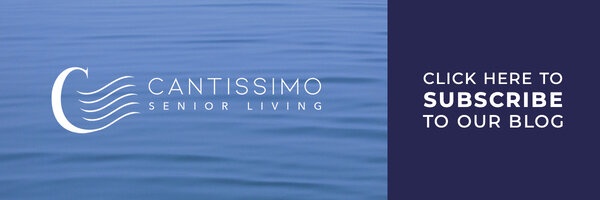Moving in your younger years probably meant simply recruiting a pickup truck-owning friend...
The Big Move: A Checklist for Moving Into Assisted Living
Moving out of a family home after many decades seems akin to moving a mountain. If the move is to Assisted Living, the mountain can feel even bigger.
First, consider the situation. Often, such a move does not have a long planning runway. A sudden trigger event can start the process. Incidents like an accident (e.g., a fall in the home) or illness can put an abrupt stop to independent living and kickstart a frantic effort to move a loved one into an Assisted Living or Skilled Nursing setting.
Ridiculous Simplicity
To smooth out the process, one can use a task checklist. A checklist turns a dauntingly complex problem into a logical set of steps. As author Atul Gawande says in his book, "The Checklist Manifesto,":
"That means we need a different strategy for overcoming failure, one that builds on experience and takes advantage of the knowledge people have but somehow also makes up for our inevitable human inadequacies. And there is such a strategy—though it will seem almost ridiculous in its simplicity, maybe even crazy to those of us who have spent years carefully developing ever more advanced skills and technologies. It is a checklist."
Using a checklist ensures essential steps are not missed. Its power is acknowledged even by experts like pilots who routinely follow pre-flight checklists despite having logged thousands of hours in the air. For those taking on a once-in-a-lifetime process like moving to Assisted Living, a checklist is imperative.
A Prerequisite

Take care to consider a crucial prerequisite for this process. Instead of waiting for a triggering event to occur, become familiar with the checklist now. This has two advantages. First, knowing specifics about what's ahead allows one to prepare mentally. Setting expectations ahead of time will help all concerned to better weather the eventual emotional storm. Second, some checklist steps precede the actual move. Tackling these now avoids a rush in the future.
Checklist - Before the Move
- Start the Discussion
It's time to talk about Senior Living options with your loved one. It is essential to understand their perspective early in the process. Commonly, older adults resist change despite strong evidence that independent living is becoming risky. Hopefully, opening up a dialogue with descriptions of specific behaviors will persuade your loved one that a move is necessary.
- Get All Family Members on Board
Discuss the Assisted Living move scenario with relevant family members. Share this checklist with them to ensure they understand the scope of the project. If there is dissent about the plans or about the appropriateness of the move itself, get it out on the table. If necessary, seek a trusted third party to mediate the discussion. Everyone needs to be on the same page when the time comes for starting the move process.
- Prepare the House for Sale
 The house and grounds may need updating and clean-up to maximize sale price and ensure a quick transaction. A real estate agent can help to make a list of what needs to be done. Finish these as soon as possible to avoid a stressful last-minute push. Also, become familiar with any neighborhood or condo covenants like restrictions on dumpsters in the driveway. This can avoid headaches leading up to moving day.
The house and grounds may need updating and clean-up to maximize sale price and ensure a quick transaction. A real estate agent can help to make a list of what needs to be done. Finish these as soon as possible to avoid a stressful last-minute push. Also, become familiar with any neighborhood or condo covenants like restrictions on dumpsters in the driveway. This can avoid headaches leading up to moving day.
- Review Rental Lease Terms
Renters need to know lease terms clearly. Moving to Assisted Living can be an abrupt occurrence so breaking a lease is a risk. It may be smart to go on a month-to-month lease if moving to Assisted Living is a possibility down the line.
- Inventory the Stuff
 Make an inventory of possessions that will not be making the move to Assisted Living. For example, if a vehicle will no longer be needed, plans for selling it should be sketched out.
Make an inventory of possessions that will not be making the move to Assisted Living. For example, if a vehicle will no longer be needed, plans for selling it should be sketched out.
For possessions originally planned to be bequeathed after death, consider giving those to recipients now. This will avoid storage costs and provide the giver with the satisfaction of knowing the recipients actually received the items.
The inventory will also enable planning for the disposal of possessions. Items will be tagged for giving to friends or relatives, charity donations, storage, or junking. If there is not enough time to decide the final disposition of everything, reserve space in a reputable storage facility. This adds cost but provides flexibility if more decision time is needed.
It makes sense to research companies that specialize in "downsizing" households in these situations. Talk to a few of them to understand the costs and process to retain them for a job. For the future, make a list of companies with contact information.
- Legal Review
Become familiar with wills, trusts, and other relevant legal documents to ensure no complicating issues are hiding in the weeds. Also, think about establishing a durable power of attorney. This will come in handy if your loved one cannot legally make decisions when the time comes to make Assisted Living arrangements.
Learn more in our post, What is Elder Law?
- Financial Review
 A family member needs to learn the details of their loved one's financial situation. What resources exist to pay for Assisted Living as well as to fund the moving process? Knowing the financial constraints enables realistic planning. Also, learn about all bank accounts, credit cards, lines of credit, and other financial items. Make a list of monthly bills, current status, and customer service contact information for each.
A family member needs to learn the details of their loved one's financial situation. What resources exist to pay for Assisted Living as well as to fund the moving process? Knowing the financial constraints enables realistic planning. Also, learn about all bank accounts, credit cards, lines of credit, and other financial items. Make a list of monthly bills, current status, and customer service contact information for each.
Check for all insurance that is in force, especially long-term care insurance. Understand what it pays for and under what circumstances.
- Become Familiar with Assisted Living Options
Caregivers must educate themselves about Assisted Living options in the relevant geographic area. Visiting one or two facilities to become familiar with the transition process can be extremely helpful. When the time arrives to start searching in earnest, this foreknowledge will be invaluable. Make a list of possible options with telephone numbers and contact names so it will be easily accessible when needed.
Learn more on Cantissimo Senior Living's Housing Resources page.
Checklist – The Moving Process Begins
- Start the Search for a New Home
Returning to the earlier list of facilities, start calling to ask about availability. Expect to take time to tour the top facility choices as part of the process.
- Start the Home-Selling Process
Contract with a realtor to kick off the home selling plan.
- Reserve Time With a Downsizing Company
Get estimates from three downsizing companies to get the best price and to ensure availability when the time comes.
- Change of Address
Make address changes with Social Security, Medicare, other healthcare insurance, the post office, bank accounts, magazines, and all other billers. Cancel things like utilities that will not be needed after a specific date.
- Long-Term Care Insurance
If an LTC policy covers some Assisted Living costs, contact the insurer to get the process rolling.
- Review All Medication Records
Take an inventory of all medications, including dosages and time the medications are taken. The Assisted Living staff will need this information.
- Clothing Plan
Because living space in Assisted Living is smaller than the family home, closet space is also less. Select essential clothing for the season that will fit in that new closet space. If possible, recruit a family member who has extra closet space to store off-season clothing.
- Furniture the Fits
 Having familiar furniture helps to speed the transition to the new Assisted Living home. Find out how the space is set up in the Assisted Living apartment and choose furnishings accordingly. Sometimes furniture from the family home simply does not fit. Purchasing new furniture that appeals to the loved one can make the moving experience a little more interesting.
Having familiar furniture helps to speed the transition to the new Assisted Living home. Find out how the space is set up in the Assisted Living apartment and choose furnishings accordingly. Sometimes furniture from the family home simply does not fit. Purchasing new furniture that appeals to the loved one can make the moving experience a little more interesting.
- Prep the Assisted Living Staff
Let the staff at the Assisted Living facility know the likes and dislikes of their new resident. The transition will be more comfortable if the staff understands the newcomer's routine.
Checklist – The Move-in and After
- Find Ways to Reduce Stress
Moving day can be stressful for all participants. A good plan that all have agreed on will help to set expectations. Nevertheless, prepare to be flexible if not all goes according to plan. Also, family caregivers should try to set a positive tone leading up to and during the move. Keeping calm will help the loved one feel less stressed.
- Packing
Set up one bag with essentials that can immediately be at your fingertips. This includes:
-
- Medications and any medical devices
- Toiletries
- Hearing aids
- Everyday jewelry or daily items like a watch (do not bring expensive jewelry)
- Eyeglasses
- Purse or wallet
- Cane, walker, or wheelchair
- Copies of legal or financial paperwork
- Clothing and footwear needed for everyday use should be packed so it can be unpacked first. Other less-frequently worn items can be unpacked in later stages.
Moving boxes with photos and keepsakes should be assigned to one trusted person. This way, these hard-to-replace items will be less likely to be misplaced.
- Technology
Ensure all cords and wires for TVs, computers, tablets, and cell phones accompany their respective devices. Assign a tech-savvy family member or friend to set up all these gadgets. Also, find out the Wi-Fi password for the facility, so setting up devices will go smoothly.
- Pets
If a pet is also making the move, make sure all the essentials come along. This includes:

-
- Bowls for food and water
- Food and favorite treats
- Crate and pet bed
- Litter box and supplies
- Collar, leash, and waste bags
- Pet medications
- Pet toys
- Settling In
After a busy day, at least one family caregiver or friend should remain with the new resident for a while. This will allow an opportunity for some calm and quiet time. The facility staff will be experienced in managing first-day jitters. A smooth handoff from the familiar face to the staff will help the new resident feel more at peace with the transition.
Keep reading - find more great content on our Housing Resources and Long-term Care Resources pages for more helpful content about planning for care!







